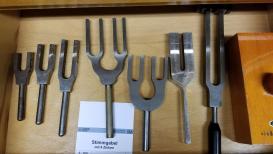There is an extensive literature on the history of acoustics in Germany, complemented by diverse collections of surviving historic acoustical instrumentation. There has yet to be a comprehensive, descriptive, and analytic inventory of these acoustical collections, however—one that could serve as a resource for exploring the complex material dimensions of this history and for mapping the making, diversity, movement, and use of objects across disciplines, precision trades, and geographies. For example, the collections in Germany hold instruments made by the prolific yet relatively understudied acoustical instrument makers Edelmann, Appunn, and Zimmermann. During my stay at the MPIWG, I am visiting several such collections related to physics, physiology, music, medicine, psychology, speech, and phonetics. This research is aided by the German portal for university collections, “Wissenschaftliche Sammlungen.”
The goals of my project are threefold: To study the instruments carefully in terms of their makers, artisanal techniques, variations, modifications, materials, use, collection context, and provenance, in order to gain a better understanding of the material foundations of acoustics; to add these findings to the growing object database “Sound & Science: Digital Histories” and to apply them in the development an exhibition on acoustics that brings together material traditions in science and music. I am also working on a broader study of the history of instruments and provenance in science collections.

